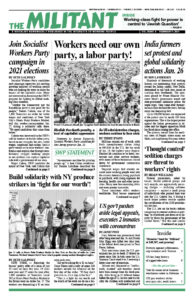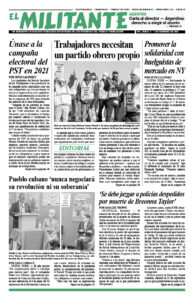BESSEMER, Ala. — “The company has been calling workers in for meetings, 20 at a time, all day, every day, to talk against the union,” Jerry Burns, who works at the Amazon fulfillment center here, often unloading trucks on the overnight shift, told the Militant.
We spoke with Burns in his apartment Jan. 14 during a two-day visit here to learn more about the union-organizing drive at Amazon, which opened its Bessemer fulfillment center last March. Because of workers’ concern about company retaliation, the Militant is using pseudonyms.
Kaitlin Estill and Ellen Brickley from Louisville, Kentucky, joined John Benson, Markie Wilson and Susan LaMont from Atlanta on the two-day team, going door to door here and in nearby Hueytown to meet Amazon workers. We also talked with other workers in the community to find out what they thought and to build solidarity with the organizing drive.
Bessemer is a suburb of Birmingham, at the center of a region where many steelworkers, coal miners and other union workers live.
Hundreds of Amazon workers signed cards for the Retail, Wholesale and Department Store Union over the fall, resulting in a National Labor Relations Board decision in December calling for a union-representation election. On Jan. 15 the NLRB set the dates for the mail-in election for Feb. 8 through March 29.
Much of the NLRB’s 13-page decision is devoted to explaining the reason for setting a mail-in vote, based on the high rates of COVID-19 infections in Alabama. The RWDSU backed the mail-in vote proposal.
The NLRB also explains that most of the center’s roughly 6,000 employees will be eligible to vote, including many job categories in addition to production worker.
This means workers who support the union face an additional challenge in convincing the broadest number of eligible employees that they should vote “yes.” The outcome is being closely watched by retail and other workers around the country, as well as the capitalist bosses, who fear workers taking steps toward union organization.
‘They try to scare us’
“They’re basically trying to scare us, telling us the union will take $500 a year from us for union dues, that we’ll lose our insurance, and that we’ll all have to go on strike,” Burns said.
“The company decided because of COVID, one worker by themselves has to unload the trucks that come in,” he said, showing us a cellphone photo of what the inside of one of the trucks looks like. “The job is hard, so you’re only supposed to do one three-hour stint per shift. But last night they forced me to unload three times, back to back. My body was so messed up from that they let me go home early.”
“I’m really with the union,” said Burns, who is 25. “And so are a lot of the guys I work with.”
He described how company people with safety vests are spying on workers, taking pictures and keeping tabs on them, supposedly to “enforce social distancing.”
“I’m moving out of my grandmother’s apartment for the first time. I’ll be paying rent then and I also have a 5-year-old son to support,” he said.
We discussed the United Steelworkers union winning a monthlong strike at the Constellium aluminum plant in Muscle Shoals. “I’m trying to understand what a strike would mean,” he said.
“Solidarity means everything in a strike,” Estill said. “When workers walk out, they try to win support from other unions and from working people and small businesses in the community, to get help with food, bills and other necessities for strikers and their families. Some unions also have strike pay.”
“One example of what workers’ solidarity, discipline and determination can achieve was during the 1955-56 Montgomery bus boycott,” LaMont said. She described the yearlong disciplined battle that finally forced the city to desegregate the buses, hire Black drivers, and at least begin to treat Black passengers with some courtesy. “Workers and unionists around the country, including Socialist Workers Party members, helped bring station wagons to Montgomery and built support for the boycott. That solidarity was key.
“One of the leaders of the boycott was E.D. Nixon, a railroad worker and president of the area chapter of the Sleeping Car Porters union, and a central leader of the NAACP along with Rosa Parks,” LaMont said. “The boycott was a masterpiece of organization to get workers to and from their jobs every day for a year, without the buses! Even though it was hard, the Black community of Montgomery and their supporters felt proud of what they were doing and the impact it was having, fighting to end Jim Crow on the bus line.”
“I’ve heard about the Montgomery bus boycott my whole life, but I never really knew what it was and what it meant until now,” Burns said. “This means so much to me, knowing what being part of a union can mean, if we stick together.”
Later that day we met Sharon Franklin, a 26-year-old Amazon worker who lives with her grandmother. Sitting around her dining-room table, Franklin described her job filling orders, trying to handle the pick rate of 300 items an hour.
“I signed a union card,” she said. “Now the company’s sending us texts and showing us videos, with the message, ‘Vote NO!’”
‘Need to get more from Amazon’
“When the union started getting cards signed last fall,” Franklin said, “the company right away gave us a 30-cent-an-hour raise. Thirty cents! That’s nothing.”
“At Amazon you clock in on your cellphone,” Franklin said. “Then you have 18 minutes to get to your station. But a lot of times you have to wait for a manager to come to give you your assignment,” she said. If you don’t make it to your station in time, or take longer than the company deems necessary to go to the bathroom, workers can be written up “TOT” — “time off task.”
Franklin is a former Walmart worker and has three young children, two of whom live with her and her grandmother. She spends $200 a week on child care in order to keep her job. Her grandfather is a retired coal miner and member of the United Mine Workers Union. “Me and my friends want a ‘yes’ vote,” Franklin said. “We need to get more from Amazon.”
Kaitlin Estill contributed to this article.

